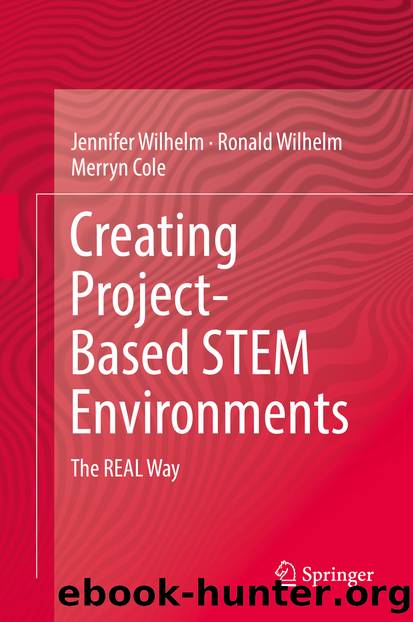Creating Project-Based STEM Environments by Jennifer Wilhelm & Ronald Wilhelm & Merryn Cole

Author:Jennifer Wilhelm & Ronald Wilhelm & Merryn Cole
Language: eng
Format: epub
ISBN: 9783030049522
Publisher: Springer International Publishing
Literature Review
Gabel (2005) suggests there are two main reasons students struggle with understanding chemistry: (1) most of the instruction is at the symbolic level, assuming students can make their own connections to the macroscopic and submicroscopic levels, and (2) students have their own conceptions about how the natural world works, including misconceptions about basic chemistry. She discusses the issue that most instruction in chemistry is at the symbolic level, but students need to engage with all three levels – macroscopic, submicroscopic, and symbolic – to really understand chemistry. CREATES follows the progression of chemistry ideas that are present in both Gabel’s work and the NGSS. The lessons ask for both macroscopic observations and particulate (i.e., submicroscopic level) explanations for phenomena under consideration. For example, rather than weighing the system prior to and after a reaction to show that mass was conserved, the CREATES lesson also asks students to make observations and model the products and reactants. An emphasis is placed on the students modeling both the macroscopic view and the particulate view.
The particulate nature of matter refers to the atomic, molecular, and ionic interactions that result in chemical phenomena (Bunce & Gabel, 2002; Gabel, 1999; Johnstone, 1991). The particulate nature of matter is a concept that states (1) matter is composed of tiny, individual particles, (2) the particles are always in motion, and (3) the nature of the particles and their interactions define the properties of matter (Nyachwaya et al., 2011). When discussing the importance of the particulate nature of matter, Margel, Eylon, and Scherz (2008) said that understanding the concept of the particulate nature of matter illuminates “relationships between structure, properties, and applications of materials, which will in turn help us understand phenomena in the world around us” (p. 135).
Understanding that matter is made up of particles (i.e., atoms, molecules, and ions) is important in order for students to understand how or why chemistry happens. Smith, Wiser, Anderson, and Krajcik (2006) asserted “understanding the atomic-molecular theory depends crucially on the macroscopic big ideas studied earlier (e.g., the understanding that matter has weight and occupies space) and, at the same time, it provides deeper explanatory accounts of macroscopic properties and phenomena” (p. 12). If students are unable to envision that matter is composed of tiny particles, they will not be able to understand how these particles interact through chemical reactions or physical processes. Wright (2003) asserts “when students learn about atoms they are given the key to unlocking many of the doors across the sciences, in physics, chemistry, biology, and earth science” (p. 18).
Others have found children’s beliefs about matter are fragmented rather than being part of a true explanatory framework. In addition, children’s views of matter seemed to be more descriptive than explanatory; they viewed macroscopic properties as intrinsic properties of the substance (Nakhleh & Samarapungavan, 1999). They also noted that children’s conceptions of matter were not consistently developed across the spectrum; some exhibited different views of solids versus liquids or gases. Researchers also found middle school students are
Download
This site does not store any files on its server. We only index and link to content provided by other sites. Please contact the content providers to delete copyright contents if any and email us, we'll remove relevant links or contents immediately.
The Art of Coaching Workbook by Elena Aguilar(48059)
Trainspotting by Irvine Welsh(20052)
Twilight of the Idols With the Antichrist and Ecce Homo by Friedrich Nietzsche(17705)
Fangirl by Rainbow Rowell(7832)
Periodization Training for Sports by Tudor Bompa(7327)
Change Your Questions, Change Your Life by Marilee Adams(6639)
This Is How You Lose Her by Junot Diaz(5768)
Grit by Angela Duckworth(4735)
Red Sparrow by Jason Matthews(4663)
Asking the Right Questions: A Guide to Critical Thinking by M. Neil Browne & Stuart M. Keeley(4573)
Paper Towns by Green John(4169)
Room 212 by Kate Stewart(4102)
Ken Follett - World without end by Ken Follett(3972)
The Sports Rules Book by Human Kinetics(3586)
Housekeeping by Marilynne Robinson(3401)
The Motorcycle Diaries by Ernesto Che Guevara(3332)
Introduction to Kinesiology by Shirl J. Hoffman(3299)
Exercise Technique Manual for Resistance Training by National Strength & Conditioning Association(3291)
Double Down (Diary of a Wimpy Kid Book 11) by Jeff Kinney(3272)
